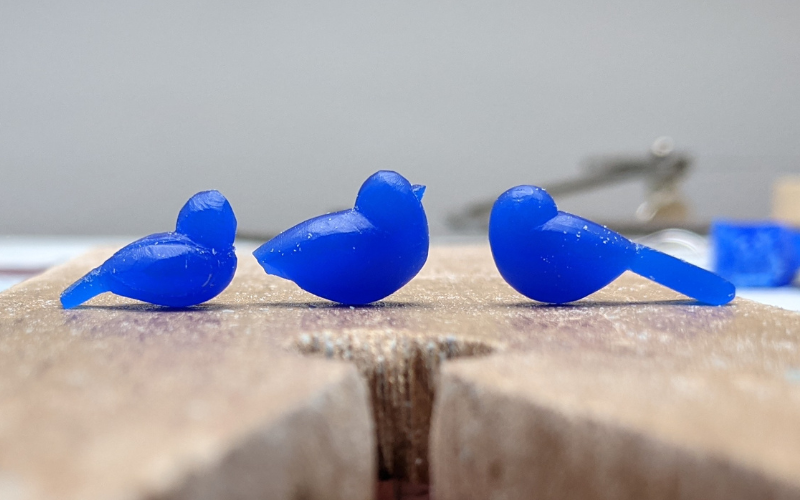Don’t give up!

Learning piece
When I make something completely new, I make it with the assumption that things will go wrong. It’s the first time I’m making it. I have an idea of how to make it, but it’s untried. I don’t know with 100% certainty that this is in fact the way it’s done. Of course it can’t go completely perfect!
That’s why I started calling all my first attempts at trying something new my learning piece. Calling it that has helped so much to not get stuck in despair when things are difficult. I’m making this piece to learn. When things go wrong and I have to adapt and try something new it’s actually exactly going to plan. When I realize it would be better if I do something different next time around, the piece is doing its job. I’m learning!
There’s no limit on the amount of things you can learn in one piece. When you hit your first learning moment keep going! If you first learn something 15 minutes in, you’re definitely learning more later on! Try to learn everything you can on that first piece. That way your second attempt can already be your real piece!
Calling it a learning piece isn’t going to prevent you from making mistakes and hitting difficult spots. It just makes it easier to move on from them and keep going! Because this is not the real piece you’ll get cast. This is just the piece you’re making to learn how to actually make the piece. And on the rare occasion that everything goes perfect from start to finish? That’s just a bonus!
Take a break
Some makes are just a struggle. Everything that can go wrong goes wrong and then some. And just because you’re still on your learning piece doesn’t mean it’s not frustrating!
When a piece is especially frustrating and anger inducing it’s ok (necessary even) to take a break from it. Notice how I say break, I’m not suggesting you should give up on the piece completely. Put the piece away for a week and work on something else. When you take it back out and look at it with fresh eyes things are not as terrible as they seemed before.
When I have a frustrating make it’s usually because the piece doesn’t look like I want it to, but I don’t know what it needs to make it look good. I stop working on it, but leave the piece on my bench somewhere I can see it. I pick it up, look at it from different angles, and put it back down again a few times a day. I’m not working on it, I’m just giving my brain time to work out in the background what needs to happen.
And then suddenly I’ll just know what needs to happen! And once I know it seems so obvious that I can’t believe I didn’t see it before. When you’re extremely frustrated with a piece it’s hard to think clearly. You’re just piling on mistake after mistake until it feels like you don’t know what you’re doing and you should just quit. Don’t quit, but rest. Let it marinate in the background and get back to it when you can look at the piece with fresh eyes.
Look critically
You’re your own worst critic. You’re filled with praise and compliments for the work of your friends. But when it’s time to take a compliment for your own work? I’m sure you’ve taken the compliment and added a ‘yeah but this part right here isn’t like it’s supposed to…’ on more than one occasion.
I don’t think that’s the critic in you speaking, it’s your emotions. It’s the sadness/anger/shame/doubt/frustration that there’s something not absolutely perfect about your piece. You’re emotionally attached to it. You KNOW all the parts you shoulda woulda coulda done better, even when you can’t SEE those parts. It’s why you have no problem giving praise and compliments to others' work, you’re not emotionally attached to it. And have difficulty receiving those compliments and praise yourself, you're emotionally attached to it.
Next time you’re stuck on a piece and are considering giving up, try to look at your piece critically, without any emotions. Does it look good? Forget that the curve was supposed to go differently, but something went wrong and this is what you ended up with. Does this curve that you have look good? Yes? Then keep going, you’re doing great!
Perseverance
The most important skill you can learn when wax carving is perseverance. To keep going and not give up when it gets difficult. Of course everything is more fun and enjoyable when things are easy and everything goes like it’s supposed to. But we all know those pieces don’t happen very often. Something eventually comes up. And what do you do when that happens? Give up on your piece or keep going?
In hindsight the struggle pieces are the ones you learn most from. They make you adapt and push yourself, they grow your carving skills. You’re never done learning. When things are difficult remind yourself of all the things you’ve learned so far making the piece. And when you feel like giving up, take a rest instead. Keep going and don’t give up!
Comment below and let me know if you're going to keep working on a difficult piece after reading this encouragement to you!